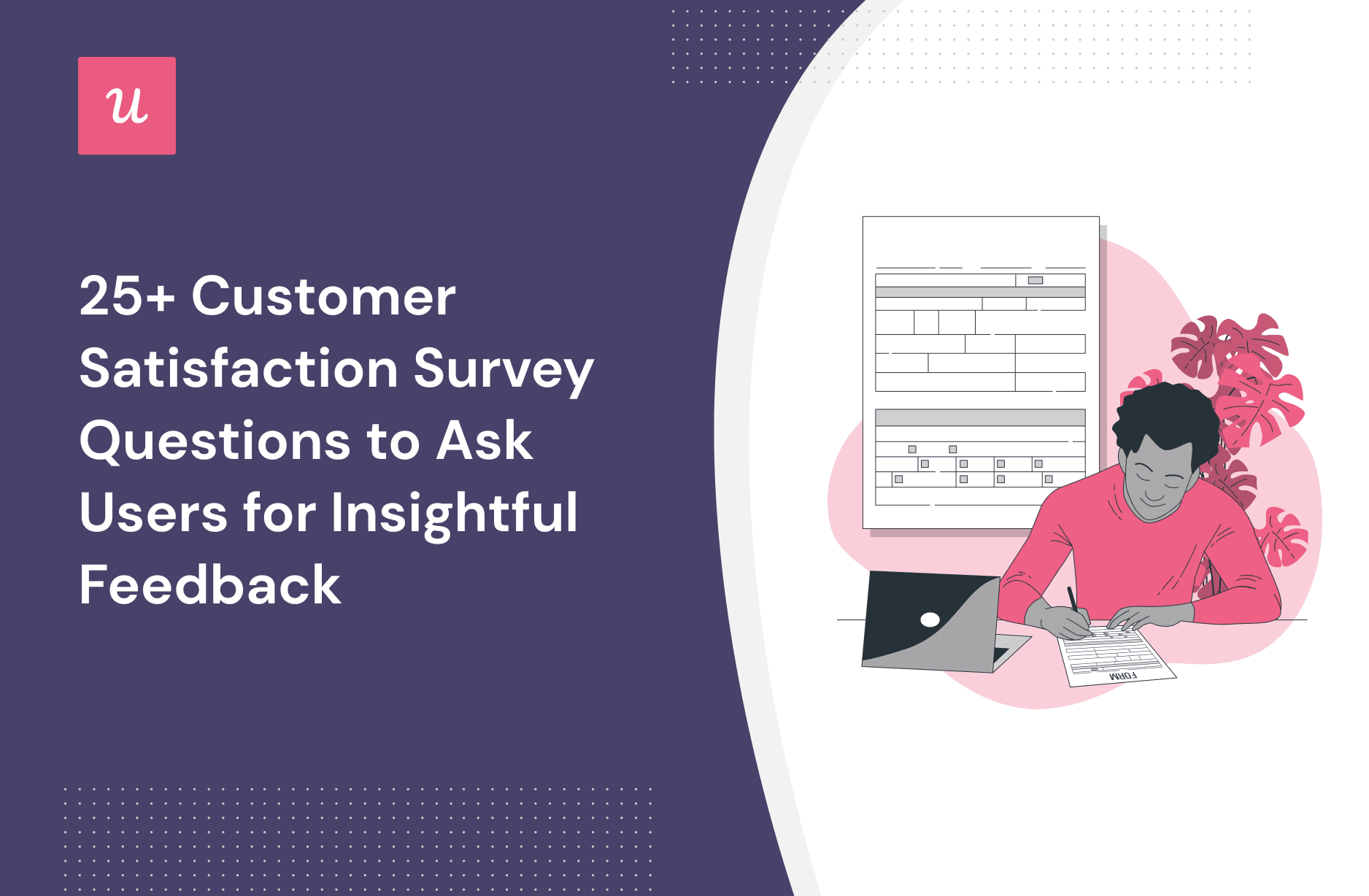
25+ Customer Satisfaction Survey Questions to Ask Users for Insightful Feedback
What are the right questions to ask your customers to understand user sentiment? It’s crucial to listen to the voice of the customer and let their feedback guide your company’s growth and sustainability. And to do that, you must ask the right customer satisfaction survey questions.
Thus in this article, we will go over 25+ customer satisfaction survey questions that you can ask users to get valuable feedback and use the insights to make data-driven decisions.
Try Userpilot Now
See Why 1,000+ Teams Choose Userpilot

What is a customer satisfaction survey?
A customer satisfaction survey is a questionnaire designed to measure customer satisfaction levels and collect feedback about the user experience across the customer lifecycle.
What are the benefits of customer satisfaction surveys?
How do customer satisfaction surveys help build a customer-oriented product? Let’s look at some of their key benefits.
- Understand if you’re meeting customer expectations: Customer feedback and opinions make you more capable of meeting your target customers’ expectations. So you get more opportunities to exceed these expectations and deliver superior value.
- Provide insightful data for improving customer satisfaction: The insights from client satisfaction surveys help you understand changing customer needs. As a result, you can develop well-informed strategies to improve customer satisfaction.
- Improve customer retention and loyalty: The insights help you make continuous improvements for power users and proactively reach out to dissatisfied customers. Thus, you can improve loyalty and retention.
What are the 4 types of customer satisfaction surveys?
Here are the 4 most crucial customer satisfaction surveys.
- Net Promoter Score surveys: NPS surveys ask users to rate their likelihood of recommending a product to others on a scale from 1 to 10 (1 = ‘Least Likely’ and 10 = ‘Extremely Likely’).
- Customer satisfaction score surveys: The customer satisfaction (CSAT) survey asks users to rate their overall satisfaction with an experience, typically on a numerical scale or a disagree-agree Likert scale.
- Customer effort score surveys: CES surveys ask users to rate the effort they have to give to navigate your product, solve a problem, find information, or perform other activities.
- Product-market fit surveys: The PMF surveys ask users how disappointed they would be if they cannot use your product anymore, and provides three choices – very disappointed, somewhat disappointed, and not disappointed.
Best practices for creating customer satisfaction survey questions
There’s no fixed question for any customer satisfaction survey. The SaaS metrics you want to measure will determine the type of questions you use in customer satisfaction surveys.
In addition, adequately designed surveys offer insights that become the basis for benchmarking customer satisfaction. So let’s check out some best practices for crafting the questions.
Avoid asking for multiple pieces of information at a time
Microsurveys are the best for reducing cognitive loads. Your customers will probably lose interest in the survey if the questions are lengthy. Again, they might get confused if you ask multiple questions at a time.
Moreover, customers become more prone to making errors if you ask for several pieces of information. Therefore, concise surveys increase data accuracy.
Further, when you ask open-ended questions, you should keep the minimum character count low. This makes it simpler for customers to answer and easier for you to analyze qualitative feedback.
Open-ended questions should also be optional. Otherwise, you can offer a reward for answering mandatory qualitative questions.
Use simple and clear survey questions that avoid bias
Don’t ask double-barrelled questions. These questions incorporate more than one issue but only allow for one answer. Thus, customers get confused, and you end up with skewed data as you don’t know the exact issue a customer commented on.
One example of a double-barrelled question is: “How engaging and informative was our recent blog post, on a scale from 1 to 5?”. The rating will be skewed since the post can be engaging without giving out all the necessary information.
Furthermore, it’s best to avoid questions with adjectives or a tone that shows personal judgment. For instance, if you ask customers, “Do you think our customer service is excellent?” they may become biased toward a positive response.
Ask relevant questions
The questions must be relevant to the precise information you need to know. Focus on the aspects of your product or service that are the most critical to your users across their customer journey.
You can segment customers based on common characteristics, like in-app behavior. This will help you send the proper surveys to relevant customers at the right time. For example, you can send an NPS survey to your ‘new users’ segment a few weeks after subscribing to your product.
Ask closed and open-ended questions
Close the feedback loop by collecting both qualitative and quantitative data. For example, Userpilot allows you to add a qualitative follow-up question to NPS surveys.
Open-ended questions offer deeper insights by allowing respondents to share their honest feedback in detail. Therefore, enhancing the customer experience and exceeding their expectations become easier.

Types of customer satisfaction survey questions
There are 5 types of customer satisfaction survey questions:
- Likert scale questions
- Rating scale questions
- Dichotomy questions
- Multiple choice questions
- Open-ended questions.
Likert scale questions
Questions on a Likert scale measure the respondent’s level of disagreement or agreement on a scale of 5, 7, or 9 points. The response options track customer sentiment on a spectrum, from one extreme to another.
Let’s look at an example.
How satisfied are you with the quality of our core feature X?
- Extremely dissatisfied
- Dissatisfied
- Neither satisfied nor dissatisfied
- Satisfied
- Extremely satisfied.
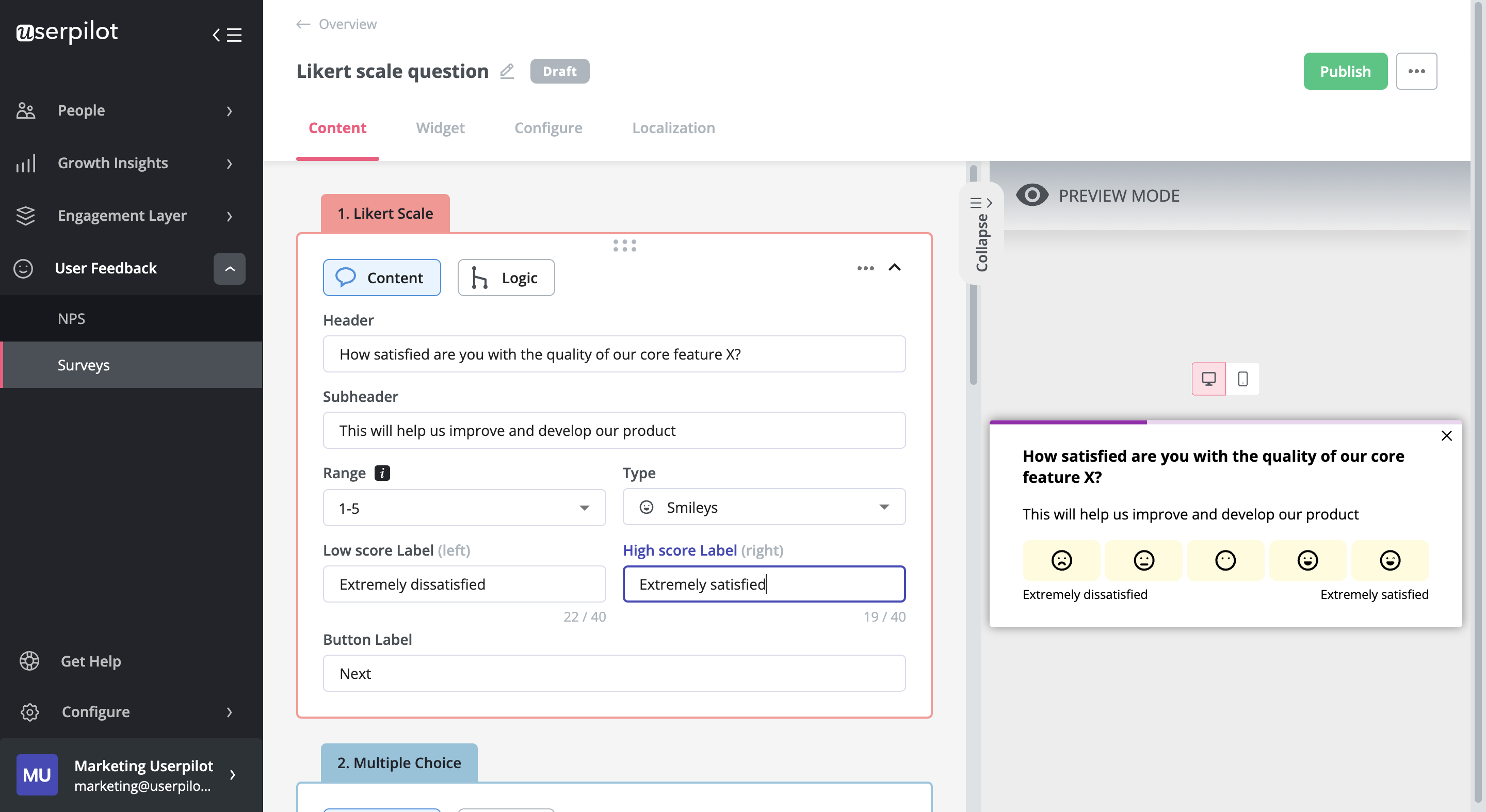
Rating scale questions
The rating scale questions provide a range of rating choices (such as 1-5, 1-10, etc.). As a result, they are useful for understanding the extent to which the respondents agree with a specific statement or how likely the respondents are to do something.
Rating scale questions are popularly used for measuring customer satisfaction. Here’s an example.
How would you rate our product’s usefulness on a scale from 1 to 10 (1 = ‘Not useful at all and 10 = ‘Extremely useful’)?
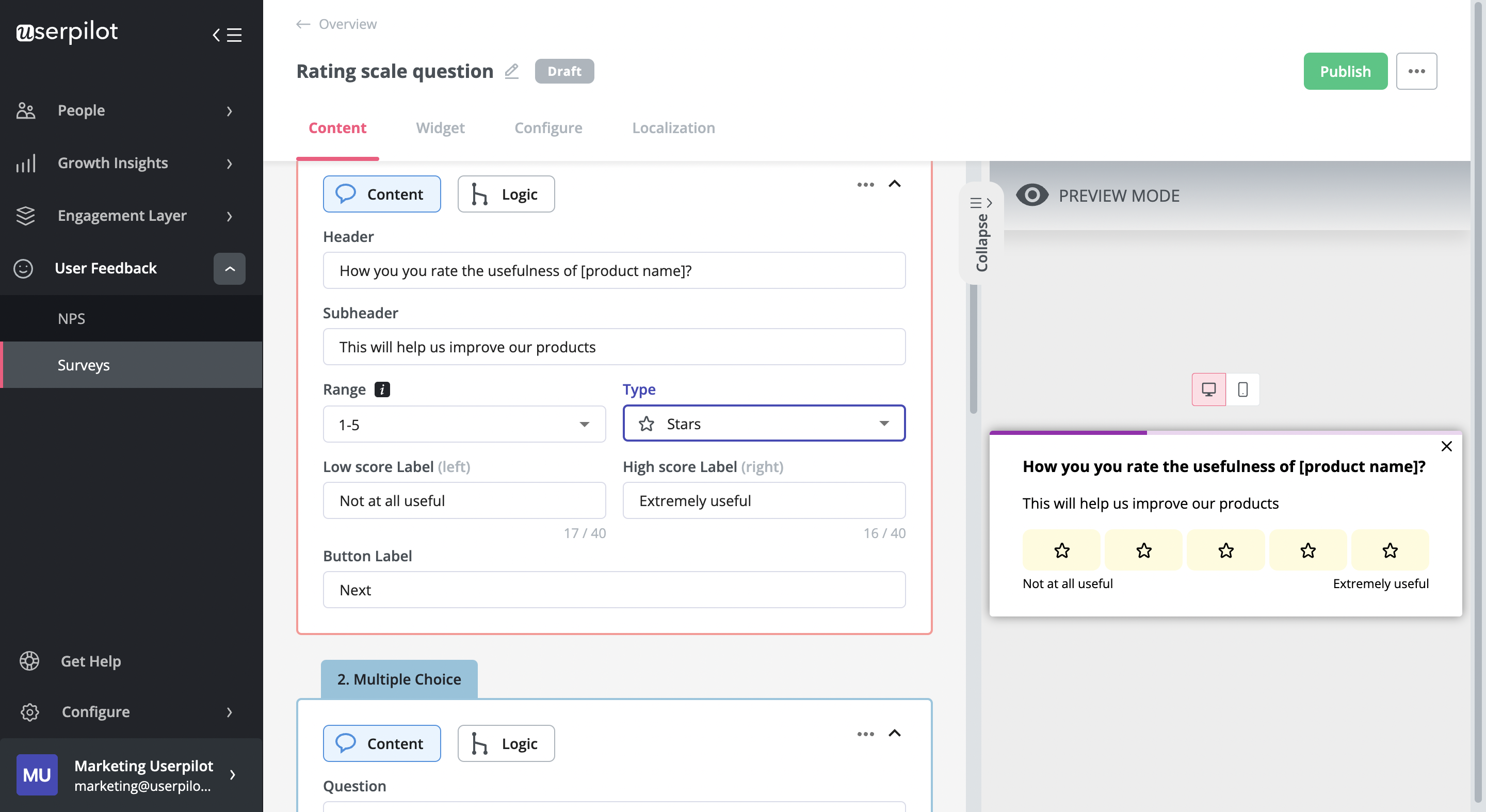
Dichotomy questions
These customer survey questions allow respondents to choose between two opposing answers. Dichotomy questions are usually presented in the following format – happy/unhappy, yes/no, agree/disagree, etc. They help assess user preferences or opinions on a specific issue.
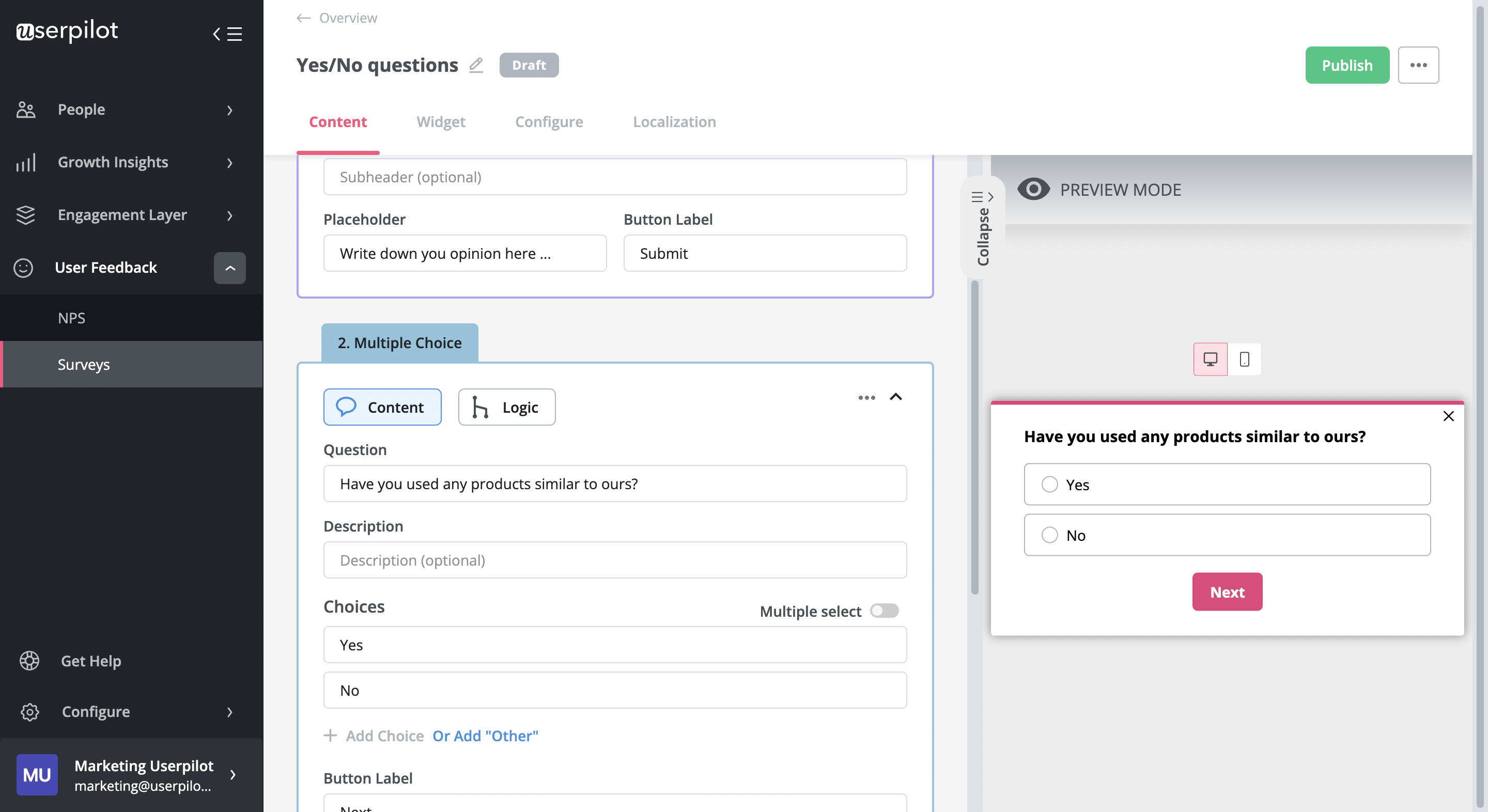
Multiple choice questions
The multiple-choice questions provide a set of predefined response options or alternatives. Respondents are either allowed to choose multiple options from the list. For example, they can choose multiple options when asked, “What improvements would you like to see in our product?”.
Moreover, multiple-choice questions can restrict the answer to only one appropriate alternative. Such as, in this case, “Which of the following features of our product is the most important to you?”.
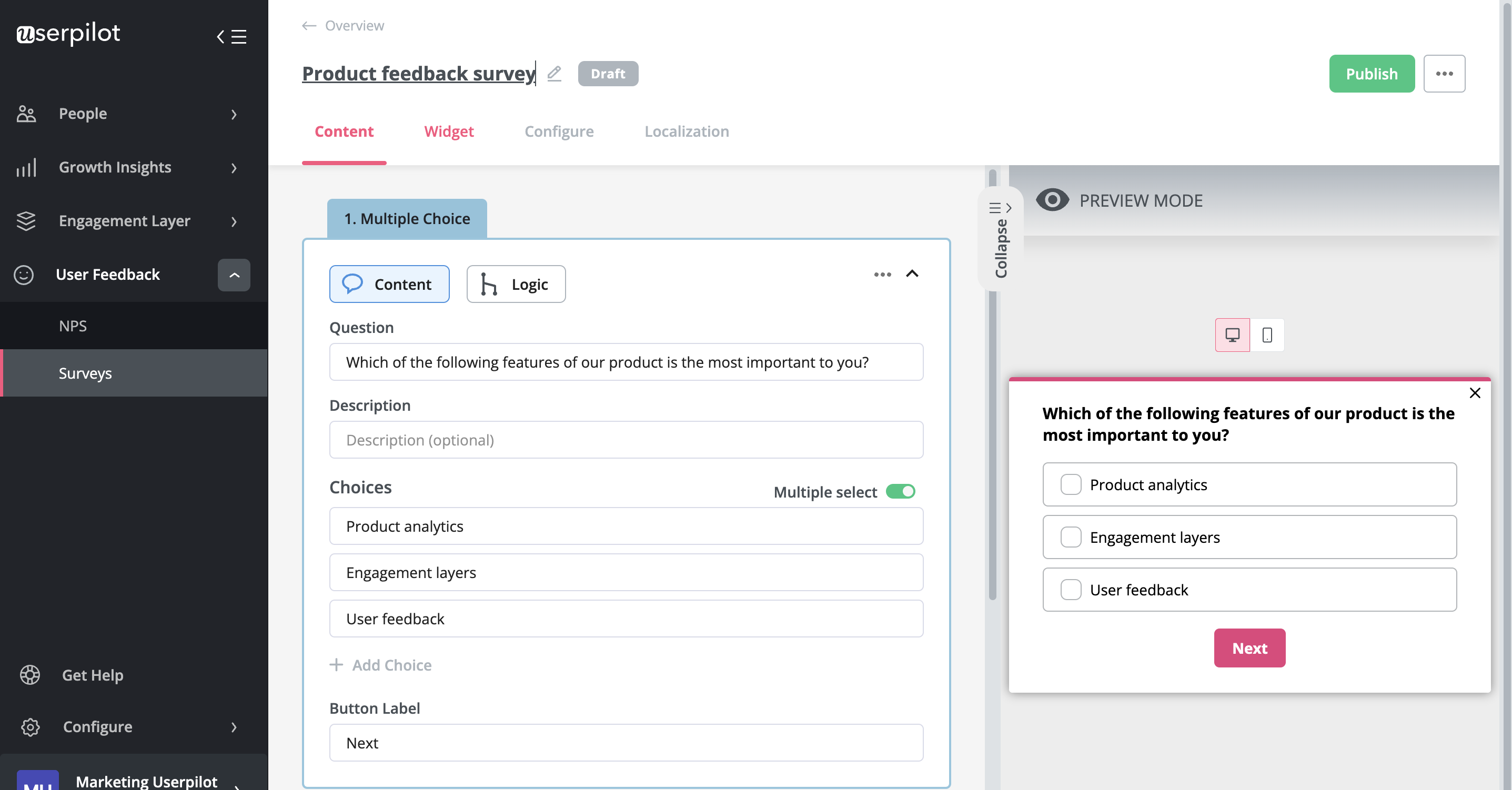
Open-ended questions
Such questions let respondents give a free-form response to reveal new actionable insights and perspectives. Analyzing qualitative data gives you a deeper understanding of user behavior and their level of satisfaction.
Now that you know the different kinds of customer satisfaction survey questions and the best practices for designing these surveys, let’s dive into the examples for each survey type.
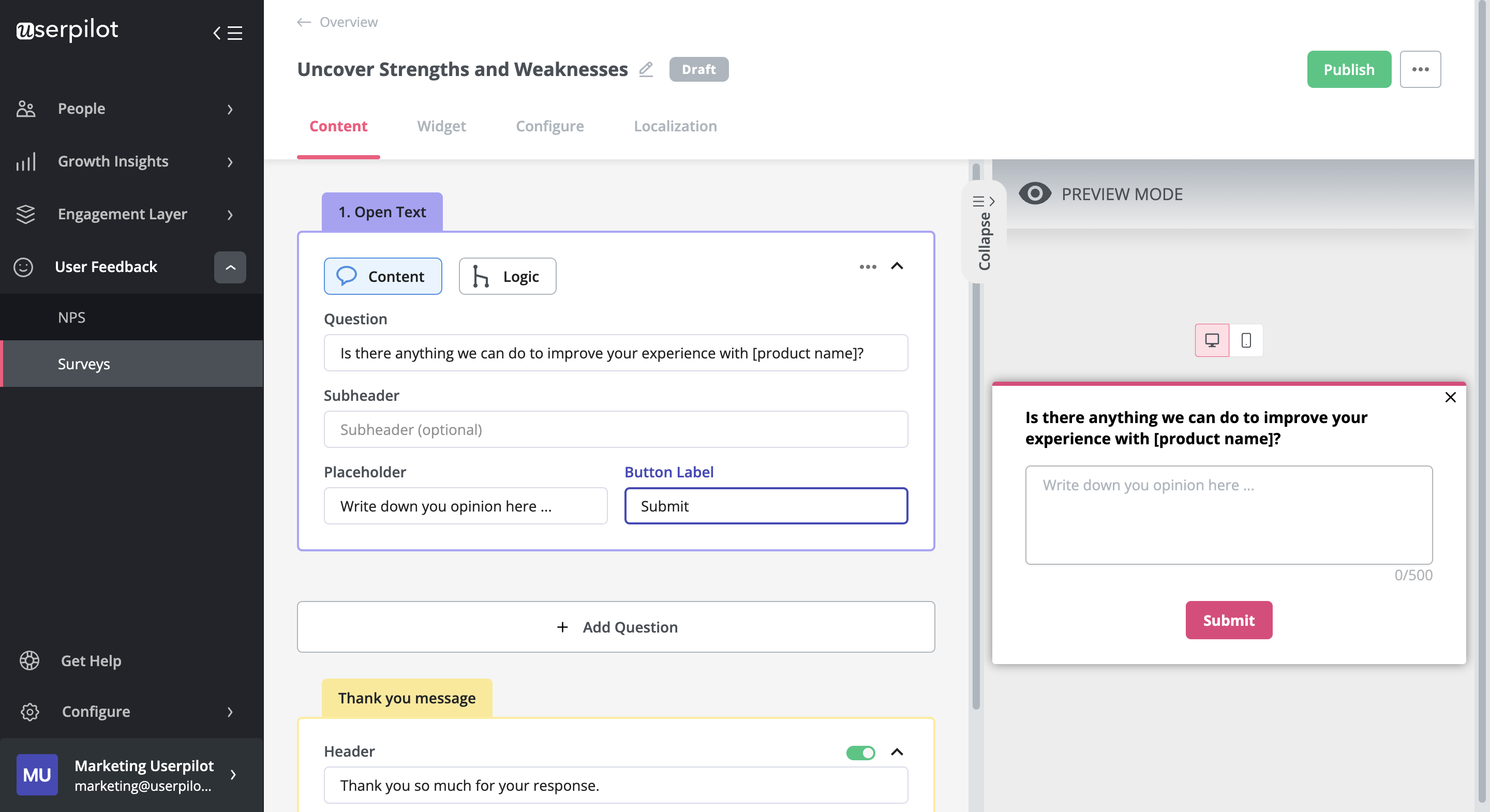
Net promoter score survey question examples
NPS surveys collect customer feedback on the overall customer experience with your product or service. The most effective NPS surveys use a combination of close-ended and open-ended questions. This way, you can identify your strengths and weaknesses from promoters and detractors.
Here are some variations of NPS survey questions. You can use only one question for each type.
Close-ended questions for NPS surveys
- How likely are you to recommend our product to a colleague/friend?
- Based on your experience with our product, how would you rate your likelihood of recommending it to others?
- How likely are you to recommend (brand/product name) to individuals with similar challenges?
Follow-up questions for NPS surveys (open-ended questions)
- What issues or challenges have you experienced with our product?
- What did you find disappointing about or missing in your experience with us?
- Is there anything we could do to make our product even better?
- How can we improve your experience?
- How can we improve our product to meet your needs better?

Customer satisfaction survey question examples
CSAT surveys are typically used to gauge customer reactions to a particular experience with your product. However, it can also be used to assess their overall satisfaction level.
Here are some variations of CSAT survey questions from which you can choose any relevant one.
CSAT survey question examples
- How satisfied are you with our product?
- How satisfied are you with the overall value for money of our product/service?
- Please rate your satisfaction with our customer service team in resolving your issue.
- How was your onboarding experience?
- Was the customer service representative helpful in resolving your issue?
- How would you rate your experience with this feature today?
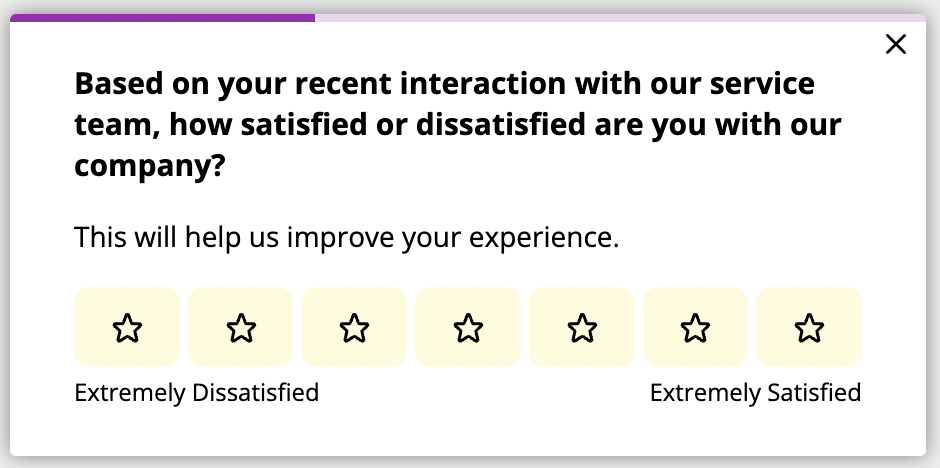
Customer effort score survey question examples
CES surveys evaluate the perceived effort in completing a particular activity. So they are best triggered after a customer has engaged with customer support, used a feature for the first time, or reached a milestone in their customer journey.
Here are some variations of CES survey questions from which you can choose any relevant one.
CES survey question examples
- How easy was it for you to use this feature?
- Please tell us about your experience setting up our product.
- How easy was it to learn how to use our product?
- How was your experience navigating this feature?

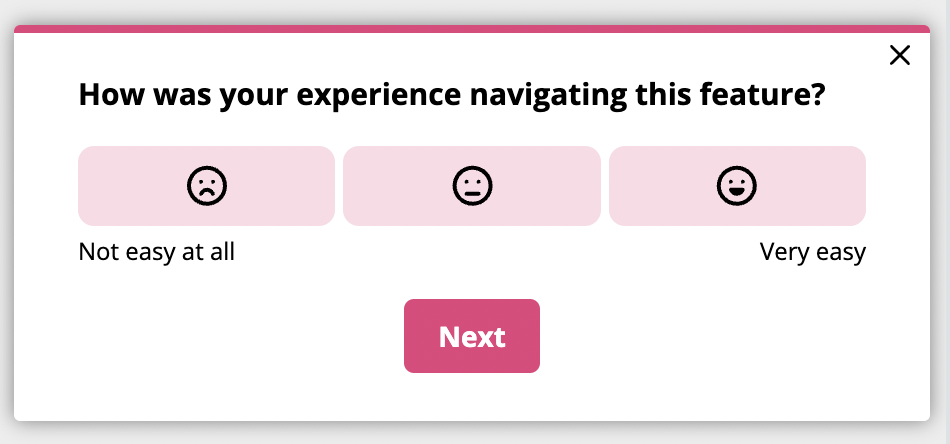
Product-market fit survey question examples
PMF is the best indicator of continuous demand for your product. At least 40% of your customers should be disappointed if they can longer use your product. This proves you’ve achieved product-market fit and can capture a significant market share by scaling your product.
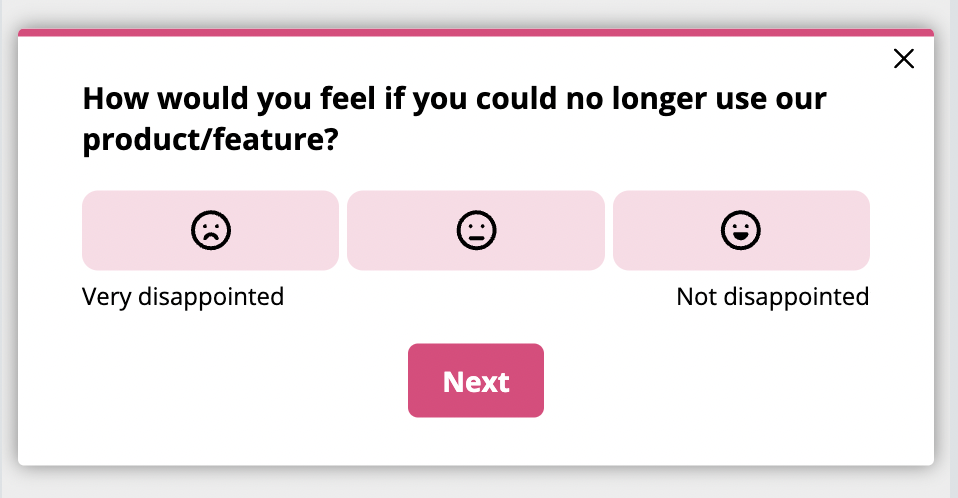
Here are some variations of PMF survey questions from which you can choose any relevant one.
PMF survey question examples
- How would you feel if you could no longer use our product/feature?
Apart from the PMF question above, here are some other questions that can help you understand if you have achieved product market fit:
- If you have tried alternative products, which one(s) did you try?
- Did our product/service solve your problem?
- What [product/service] functionality could you not live without?
- How well does our product meet your business needs?
- Were you able to accomplish your goals using our product/service?
- How does our product compare to the alternative products you’ve tried in terms of meeting your needs?
Best customer satisfaction survey examples
Here are some customer satisfaction survey questions from real-life businesses. Notice that all the questions are short and easy to interpret, thus making them engaging to respondents.
Nicereply’s customer effort score survey
The CES survey below uses 7 Likert scale questions on the disagree-agree scale to know how much effort a customer gives to handle an issue. The less effort they need to give, the more satisfied users will be with your product.
The question is in a statement format. Additionally, the option to choose ‘somewhat disagree’ or ‘somewhat agree’ can give more accurate results from users who would’ve otherwise chosen to stay neutral.

Miro’s passive customer satisfaction survey
Miro has an always-on feedback button inside its learning center that triggers a survey to rate the center’s effectiveness.
The survey below uses emoticons as response options to make it more engaging and increase the response rate. You can assign Likert scale numbers to the emoticons in such surveys to analyze the feedback.

Hubspot’s customer onboarding experience survey via email
HubSpot sends its onboarding experience survey through email (not in-app) to discover friction points early in the onboarding process. The smiley faces make the survey more engaging. The insights from such experience surveys help to improve product adoption and user retention.

Groove’s Net Promoter Score survey with a follow-up question
The NPS survey lets you segment your customers into three groups:
- Promoters (who rate you 9 or 10)
- Passives (who rate you 7 or 8), and
- Detractors (who rate you 6 or less).
Below is a typical NPS survey with a follow-up question to know why a customer gave a particular rating.

Note that detractors are at high risk of churn. Analyzing the qualitative response gives valuable insights into customer pain points and helps improve the product proactively.
Airtable’s chatbot customer satisfaction survey
The image below shows a CSAT survey that uses dichotomy questions to assess the usefulness of help articles. Thus, it requires low effort to answer. Such customer service survey questions help to improve the performance of in-app self-support and observe customer service trends.

Creating customer satisfaction surveys using Userpilot
Here’s how you can build customer satisfaction surveys using Userpilot.
Create in-app surveys from scratch or use survey templates
Userpilot makes it easy to create in-app user surveys from scratch or by using customer satisfaction survey templates, completely code-free. You can customize these surveys to your brand’s style and make quick changes when needed.
Userpilot also lets you customize in-app mobile surveys with any type of question and trigger.
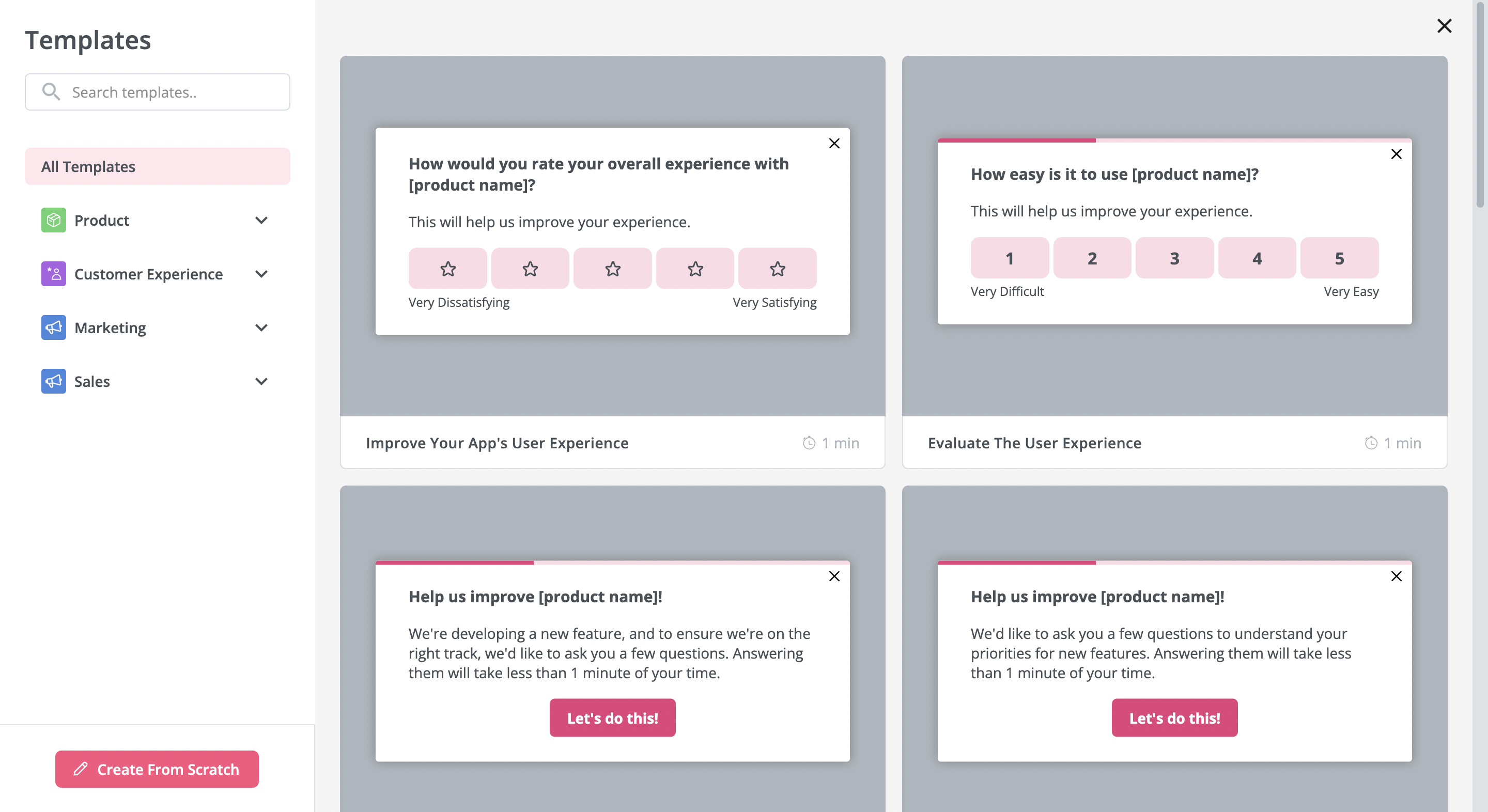
Furthermore, you can add supplementary images or micro-videos to make them more attractive, all from the same interface and without coding.
Trigger these surveys to pop up after users have completed a particular task, such as upgrading to a higher-tier subscription plan.
Trigger in-app surveys to the right user segments
Userpilot’s advanced segmentation allows you to create user segments based on criteria such as company data, NPS score, in-app behavior and more.
Therefore, it also lets you contextualize in-app surveys to the relevant segments. For example, if you want to follow up on detractors, you can trigger another NPS survey a few days after contacting them with solutions.

Analyze survey results to identify trends
The platform’s powerful user sentiment analytics help you get deeper insights, make well-informed strategies, and thus build strong long-term customer relationships.
The results are all neatly presented on a dashboard.

You can also take feature requests from the follow-up questions of surveys. For instance, Userpilot lets you tag and organize qualitative NPS responses into themes like ‘missing features.’

Conclusion
Customer feedback analysis through NPS, CSAT, CES, and PMF surveys is the key to improving customer loyalty and increasing the number of satisfied customers. The customer satisfaction survey questions must be short, engaging, and relevant to the information you need to build your business strategies.
Want to use your customer satisfaction surveys? Get a Userpilot demo and achieve sustainable growth.






